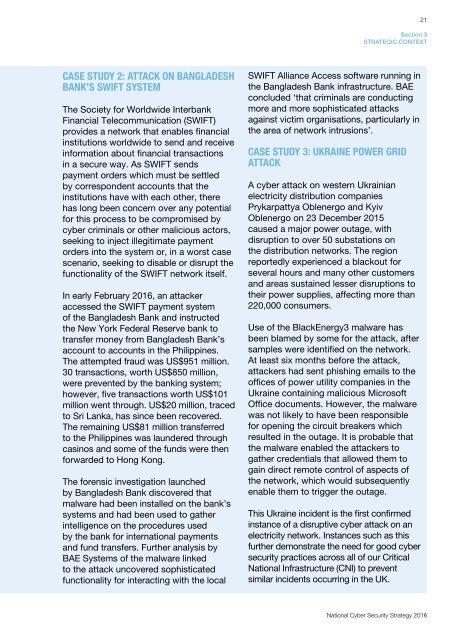NATIONAL CYBER SECURITY STRATEGY 2016-2021
2ewwH3j
2ewwH3j
Create successful ePaper yourself
Turn your PDF publications into a flip-book with our unique Google optimized e-Paper software.
21<br />
Section 3<br />
STRATEGIC CONTEXT<br />
CASE STUDY 2: ATTACK ON BANGLADESH<br />
BANK’S SWIFT SYSTEM<br />
The Society for Worldwide Interbank<br />
Financial Telecommunication (SWIFT)<br />
provides a network that enables financial<br />
institutions worldwide to send and receive<br />
information about financial transactions<br />
in a secure way. As SWIFT sends<br />
payment orders which must be settled<br />
by correspondent accounts that the<br />
institutions have with each other, there<br />
has long been concern over any potential<br />
for this process to be compromised by<br />
cyber criminals or other malicious actors,<br />
seeking to inject illegitimate payment<br />
orders into the system or, in a worst case<br />
scenario, seeking to disable or disrupt the<br />
functionality of the SWIFT network itself.<br />
In early February <strong>2016</strong>, an attacker<br />
accessed the SWIFT payment system<br />
of the Bangladesh Bank and instructed<br />
the New York Federal Reserve bank to<br />
transfer money from Bangladesh Bank’s<br />
account to accounts in the Philippines.<br />
The attempted fraud was US$951 million.<br />
30 transactions, worth US$850 million,<br />
were prevented by the banking system;<br />
however, five transactions worth US$101<br />
million went through. US$20 million, traced<br />
to Sri Lanka, has since been recovered.<br />
The remaining US$81 million transferred<br />
to the Philippines was laundered through<br />
casinos and some of the funds were then<br />
forwarded to Hong Kong.<br />
The forensic investigation launched<br />
by Bangladesh Bank discovered that<br />
malware had been installed on the bank’s<br />
systems and had been used to gather<br />
intelligence on the procedures used<br />
by the bank for international payments<br />
and fund transfers. Further analysis by<br />
BAE Systems of the malware linked<br />
to the attack uncovered sophisticated<br />
functionality for interacting with the local<br />
SWIFT Alliance Access software running in<br />
the Bangladesh Bank infrastructure. BAE<br />
concluded ‘that criminals are conducting<br />
more and more sophisticated attacks<br />
against victim organisations, particularly in<br />
the area of network intrusions’.<br />
CASE STUDY 3: UKRAINE POWER GRID<br />
ATTACK<br />
A cyber attack on western Ukrainian<br />
electricity distribution companies<br />
Prykarpattya Oblenergo and Kyiv<br />
Oblenergo on 23 December 2015<br />
caused a major power outage, with<br />
disruption to over 50 substations on<br />
the distribution networks. The region<br />
reportedly experienced a blackout for<br />
several hours and many other customers<br />
and areas sustained lesser disruptions to<br />
their power supplies, affecting more than<br />
220,000 consumers.<br />
Use of the BlackEnergy3 malware has<br />
been blamed by some for the attack, after<br />
samples were identified on the network.<br />
At least six months before the attack,<br />
attackers had sent phishing emails to the<br />
offices of power utility companies in the<br />
Ukraine containing malicious Microsoft<br />
Office documents. However, the malware<br />
was not likely to have been responsible<br />
for opening the circuit breakers which<br />
resulted in the outage. It is probable that<br />
the malware enabled the attackers to<br />
gather credentials that allowed them to<br />
gain direct remote control of aspects of<br />
the network, which would subsequently<br />
enable them to trigger the outage.<br />
This Ukraine incident is the first confirmed<br />
instance of a disruptive cyber attack on an<br />
electricity network. Instances such as this<br />
further demonstrate the need for good cyber<br />
security practices across all of our Critical<br />
National Infrastructure (CNI) to prevent<br />
similar incidents occurring in the UK.<br />
National Cyber Security Strategy <strong>2016</strong>


